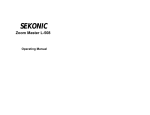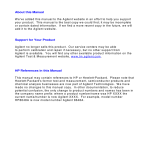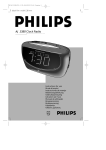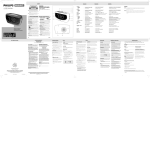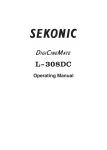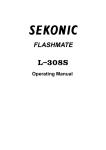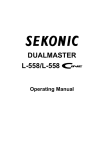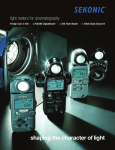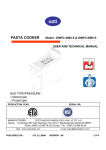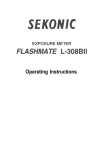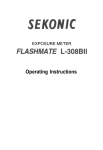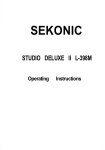Download Sekonic DIGI LITE F L-328 Operating instructions
Transcript
SEKONIC DIGI LITE F L-328 Operating Instructions Parts Designations Lumisphere Swivel Head (270° rotatable) Liquid crystal display Measuring switch Power switch UP/DOWN key Mode selection switch ISO key F/EV key Synchro terminal Battery chamber Carrying strap eyelet Lumidisc Reflected light filter Liquid Crystal Display - Display for film speed moves through a range of IS0 3 - IS0 8000 by pressing either UP or DOWN key while holding the IS0 key depressed. By pressing F/W key, the indicated symbol will be converted from F to EV, and vice versa. When the meter is used in the flash mode, only the F mark is displayed. Symbol for wireless measurement 01, wired measurement Ioc or tine mode C will be dis played depending on the mode selection. In case of ambient light measurement (excepting tine mode), no symbol is indicated here. aoa*a~mea*aoaoa 8 11 1622324564900 F-stop number is also displayed in bar-dot symbols at 112 F-stop increments. s mark appears when the measuring range is exceeded (underexposure). 5 mark appears when the measuring range is exceeded (overexposure). (1) Bar symbols indicate the fractions of F-stop or EV. (2) Battery capacity is shown when the meter is switched on. (1) Digital value of F-stop or EV measurement is shown in this display (f/l -f/90 or EV -6- EV 25). (2)b.c. (battery check) mark is displayed when the meter is switched on. or E.o. (overexposure) (3) E.u. (underexposure) mark is displayed when the measuring range is exceeded. Shutter speed (T) is shown in this display. For ambient light: 30 min. - l/8000 sec. For flash light: 1 sec. - 11500 sec. For tine camera: 8, 16, 18, 24, 32, 64 and 128 fps. 2 Preparing the Meter for Operation 1. Inserting the battery The meter uses a single AA size pen-light battery (1.5h. Open the battery chamber cover by sliding it in the direction of arrow, and insert the battery carefully aligning (+) and (-) polarities as indicated inside the chamber. Note: When not using the meter for a week or more, remove the battery from the meter. This will prevent any internal damage arising from battery leakage. 2. Checking the battery Check the battery before using the meter. A weak battery will not assure the correct light readings. Slide the power switch to ON position. Then the b.c. mark and bar symbols will be displayed. Battery capacity is indicated by the bar symbols (Fig. 1). After checking battery (for about 0.5 sec.) the display automatically changes to measuring mode (Fig. 2). If the battery is too weak to give a correct light readings, the b.c. mark will flash. Note: If you switch the meter on while depressing ISO key, the display of b.c. mark and bar symbols will keep indicating. 3. Selecting measuring mode Power on and slide the mode selection switch to the position you want; wireless measurement for flash light wired or measurement for flash light am bient light measurement 3 4. Setting ISO sensitivity Press either side of UP/DOWN key while holding ISO key depressed so that the ISO number of your film is displayed. Film speed can be set within the range of ISO 3 -ISO 8000 (Fig. 3). 5. Setting shutter speed This meter is designed for T (shutter speed) priority use, and the shutter speed should be set first. Press either side of UP/DOWN key, so the display of shutter speed can be changed in the range of 30 min.-1/8000 sec. for ambient light measurement and 1 sec.-11500 sec. for flash light measurement (Fig. 4). After the display of 1/8000 sec. the tine scale is indicated (8, 16, 18, 24, 32, 64 and 128 fps.). In case of tine mode, the symbol C is displayed (Fig. 5). Note: The set figures (ISO, shutter speed and tine scale) are memorized even after the meter is switched off. Wireless Measurement using Electronic Flash Unit In case the photographed subject is too far away to use a synchro cord, or in case the synchro cord disturbs photographing, flash light can be measured without connecting synchro cord. 1. Switch the meter on and set the mode The symselection switch at position will be indicated on the display bol of (Fig. B). 4 2. Set the film speed (ISO) and shutter speed (T) as shown in the paragraph for "Preparing the Meter for Operation". sym- 3. Press the measuring switch. The bol on the display starts flashing. 4. While the symbol is flashing (for about 90 sec.), fire the flash unit by pressing its test button (Fig. 7). 5. The appropriate F-stop value will be displayed on the meter. The measured value is indicated in a dual display by F-stop number with bar symbols and bar-dot symbol marks (Fig. 8). 6. symbol is not flashing, the It the meter cannot accept wireless flash measurement. Press the measuring switch again to make the meter ready for measurement. Note: (1) If the measuring range is exceeded, the digital F-stop number is replaced for with either mark of E.u. (and underexposure) or E.o. (and for overexposure) (Fig. 9). (2) The display will continue to indicate the measured value for about 5 minutes after measurement. After this period of time the auto-off circuit will operate and turn the display off. Measurement using Flash Unit with Synchro Cord It is recommended that the meter is used in the wired measurement mode when the flash light is measured from subject position or when the meter fails to register flash light from wireless measurement; for example, close to a fluorescent lamp, or in high ambient conditions etc. 1. Set the mode selection switch to position will be indicated on The symbol the display (Fig. 10). 2. Set the film speed (ISO) and shutter speed (r) as shown in the paragraph for "Preparing the Meter for Operation". 3. Connect the synchro cord to the synchro terminal of meter and to the flash unit. 4. Press the measuring switch to fire the flash. The appropriate F-stop value is displayed on the meter. Press the measuring switch again for repeat measurements (Fig. 11). Note: The notes for wireless measurement are also applicable to wired measurement. 6 Ambient Light Measurement Measuring ambient light, whether it is daylight or standard electric light, is a fairly simple matter using either incident or reflected light method. 2. Set the film speed (ISO) and shutter speed (T) as shown in the paragraph for "Preparing the Meter for Operation". 3. Press the measuring switch. The appropriate F-stop value is displayed on the meter (Fig. 13). 4. When the measuring switch is kept depressed in the ambient light mode, the display will give a continuous reading of the changes in brightness. 7 5. By pressing F/EV key the F/number display will be changed to the EV/number display, and vice versa. In case of EV mode the bar-dot symbols are not indicated on the display (Fig. 14). Note: The notes for wireless measurement are also applicabel to ambient light measurement. The procedures for taking measurements when using a movie camera are the same as for taking ambient light measurements. Keep depressing the UP side of UP/DOWN key. Then, after the display of 1/8000 sec., cine scales for 8, 16, 18, 24, 32, 64 and 128 fps. will be displayed, one after another. At the same time, the symbol C will be indicated on the display (Fig. 15). 8 Post-Measurement Calculation 1. By changing ISO sensitivity the measured F-stop value will automatically be altered to the appropriate one corresponding to the changed ISO value (Fig. 16) This post-measurement calculation is ap plicable to all measuring modes, wireless and wired flash light measurement, and ambient light measurement. 2. By changing the shutter speed (l) the measured F-stop value will automatically be altered to the appropriate one cor responding to the changed T value (Fig. 17). Post-measurement calculation for shutter speed (1) is only applicable to the am bient light measuring mode. If you make post-measurement calculation for T in flash light measuring mode, the indicated F-stop value will turn into 0. Contrast Metering for Lighting Balance When calculating a desired lighting balance, the meter can be used to measure the brightness of main and fill-in lightings from the subject position. t. Mount a Lumidisc instead of Lumisphere for usual incident light measurement. 2. Select the measuring mode, and set the film speed (ISO) and shutter speed (T) as shown in the paragraph for "Preparing the Meter for Operation". 3. Point the center of Lumidisc accurately toward the center and axis of the main lighting source from the subject position, and measure the light according to the measuring method for the respective mode. 4. Using the same procedure, measure the fill-in light. In this case, be sure that the meter is held so that it is not influenced by the main lighting source. 5. The F-stop difference between the main and fill-in lighting sources is the lighting contrast ratio (Fig. 18). 10 Illuminance (LUX) Measurement The meter can be used as a LUX meter when used with the Lumidisc in the ambient light measuring mode. 1. 2. 3. Mount the Lumidisc, and slide the mode selection switch to position Set the film speed (ISO) to ISO 100 regardless of your film speed. Press the F/EV key and select EV mode. 4. Hold the meter so that the Lumidisc is parallel to the plane to be measured, and press the measuring switch. 5. The measured EV value can be converted to the corresponding lux value using the Fig. 19. Accessories Lumisphere Lumidisc Reflected Light Filter Synchro Cord (sold separately) Viewfinder 5° (sold separately) • Use the Lumisphere when you wish to measure incident light for portraits and three-dimensional subjects. In case of incident light measurement, point the Lumi-sphere accurately toward the camera from the subject position. •Use the Lumidisc to measure illumination contrast or Lux as well as exposure of single-dimensional subjects. Measuring position is same as for Lumisphere. •Use the reflected light filter to measure the reflectedlight of a subject. Point the filter directly toward the part of subject to be measured. And measure the reflected light from the main part of subject as close as possible to the subject. Use adequate care in this case that the meter shadow does not interfere with the light to be measured. • A necessity for wired measurement for flash light. 5 meters in length, with 3 plugs for the synchro termials of exposure meter, flash unit and camera. • By using this viewfinder the 5° spot measurement is available. It makes you possible to measure the reflected light of distant subject without going up close to the subject, or to check the reflected light from the small part of subject. 12 Specification Measuring system • Incident and reflected light measurement Flash light for wireless and wired, and ambient light measurements Measuring element • Silicon Photo Diode Measuring range • Flash: F/1 .4-F/90+0.9 AV (ISO 100) Repeat metering • Within ±0.1 EV Ambient: EV -1-EV 19.9 (ISO 100) accuracy Calibration constants • C--340 K=12.5 Film speed • ISO 3-ISO 8000 Shutter speed • Flash: 1 sec.-1/500 sec. F-stop • F/1 .0-F/90 + 0.9 AV (digital and bar symbols) Movie scale • 8 fps.-124 fps. EV scale • EV -6-EV 25 + 0.9 Other functions • Mode symbol display, E.u. and E.o. displays, battery Ambient: 30 min.-1/8000 sec. Analogue display: F/1 - F/90 at 0.5 AV check, memory for the set values, post-measurement calculation, auto-off. Power source Standard accessories • 1 x AA pen-light battery (1.5V) • Lumisphere, Lumidisc, reflected light filter, neck strap, battery and case. Dimensions & weight • 121 x 64 x 23 mm, approx 110 grams (excl. battery) Care of Your Meter DIGI LITE F meter is a high-precision instrument containing delicate electronic parts and components, and you are recommended to handle the meter with due care. 1. Avoid dropping or shocking the meter. 2. Do not store the meter in high temperature or high humidity locations. 3. Keep Lumisphere and Lumidiscs clean and free from scratches. 4. To avoid unnecessary battery drain, keep the meter switched off unless actually in use. When no using the meter for a week or more, it is advisable to remove the battery from the meter in order to prevent any internal damage arising from battery leakage. However note that the memory settings will be tossed when the battery is removed. SEKONIC CORPORATION 7-24-14, OIZUMI-GAKUEN-CHO, NERIMA-KU, TOKYO 178-8686, JAPAN TEL:(03)3978-2335 FAX: (03)3978-5229 T19134OB-A
















